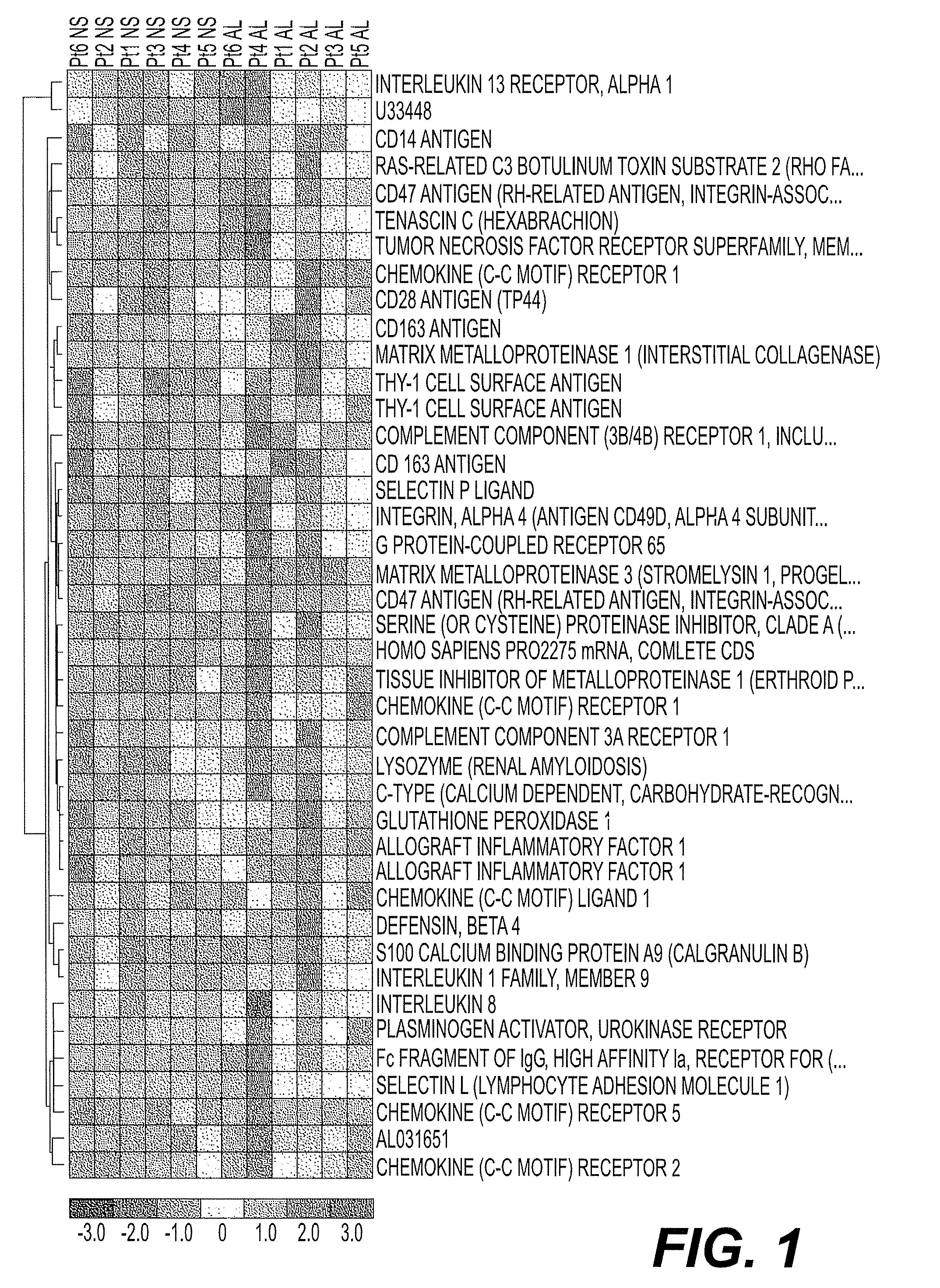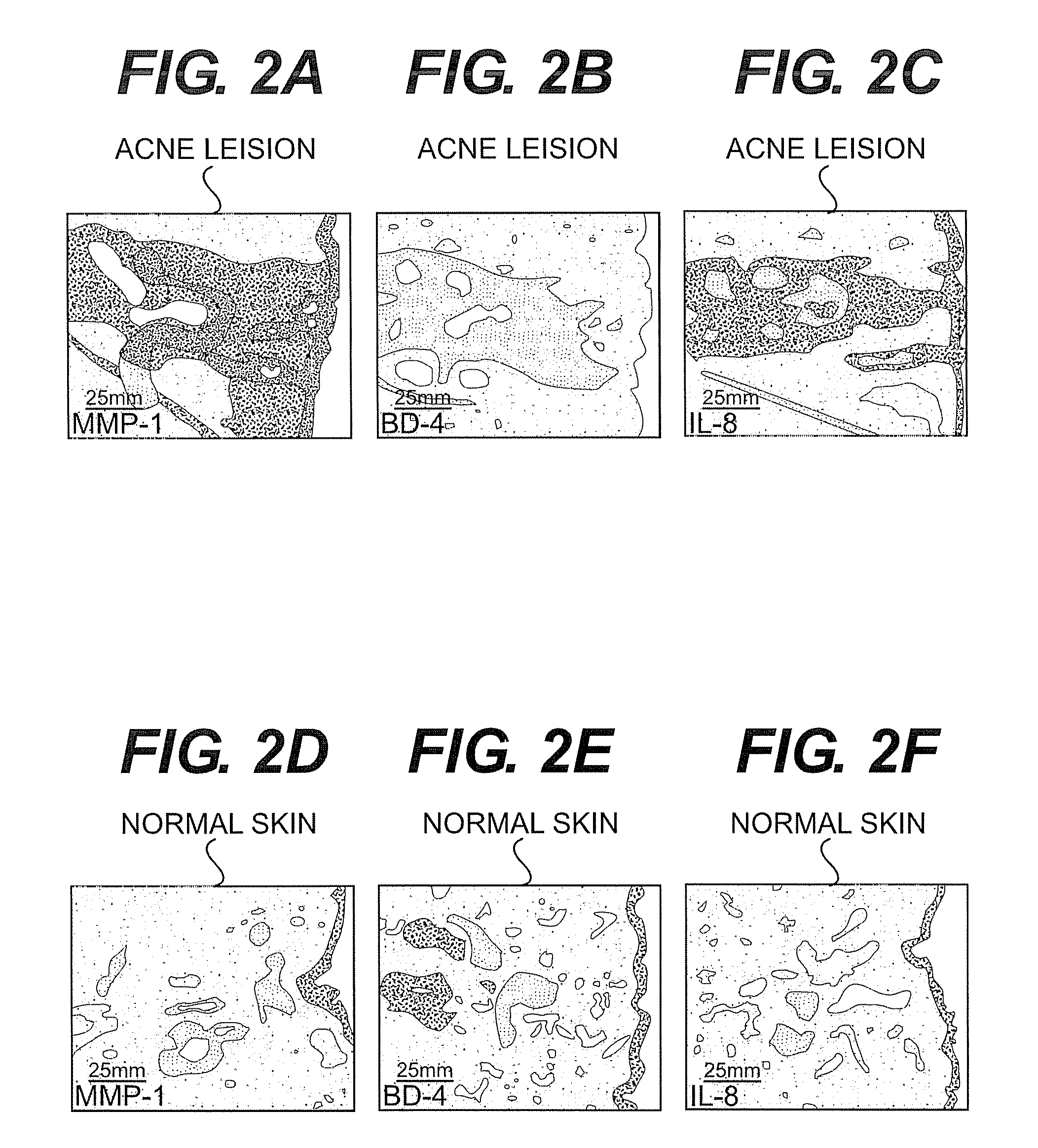Acne lesion biomarkers and modulators thereof
a technology for acne lesion and biomarkers, applied in the field of identification of acne lesion biomarkers/genes expression products pattern, can solve the problems that patients with severe acne often face significant psychological and emotional problems
- Summary
- Abstract
- Description
- Claims
- Application Information
AI Technical Summary
Benefits of technology
Problems solved by technology
Method used
Image
Examples
example 1
Expression of Inflammatory Mediators, Anti-Microbial Peptides and Matrix Metalloproteinases is Increased in Acne Lesions Compared to Uninvolved Skin
Materials:
[0103]The gene chips “HG-U133A 2.0” were purchased from Affymetrix (Santa Clara, Calif.). The MMP-1, MMP-3, IL-8, Human B-defensin 4 (HBD-4) and granzyme B primers for Real Time PCR were obtained from Applied Biosystems (California). The primary antibodies for immunohistochemistry for MMP-1 and IL-8 were purchased from R&D systems (Minneapolis, Minn.) and HBD-4 from Abcam Inc. (Cambridge, Mass.).
Patient Selection and Tissue Biopsies:
[0104]Twelve patients including male and females aged 18 to 45 years were enrolled in the study, 6 patients with acne lesions on the back and 6 subjects without acne. The inclusion criteria for the acne lesion group included: a) males and females aged 18 to 45 years with inflammatory acne on their back, b) subjects without other skin disease in the biopsy area, c) subjects who were willing to have s...
example 2
Clustering
[0115]Using the computer software dChip (Li and Wong. 2003), hierarchical clustering was conducted of the entire set of genes (229) that were significantly upregulated or downregulated from the micro-array data and found that the biopsy samples from inflammatory acne involved skin lesions clustered into a separate group from the uninvolved clinically normal skin from the same group of patients. Using the NetAffix analysis center from the affymetrix website 41 genes were identified from a total of 211 genes upregulated in inflammatory acne to be involved in inflammation. FIG. 1 is a cluster diagram of the inflammatory genes and shows the unique clustering pattern of the samples into 2 groups, one corresponding to involved skin from acne lesion and another corresponding to clinically uninvolved skin form the same group of 6 patients.
example 3
qPCR Confirms Gene Array Expression Data of Select Genes
[0116]5 Genes of interest were selected based on their fold changes and involvement in inflammation from 5 acne subjects to validate the micro-array findings using qPCR. These genes include, MMP-1, MMP-3, IL-8, β defensin 4 and Granzyme B. QPCR results were normalized to the internal control gene, TATA binding protein (TBP). A robust increase in mRNA expression was seen for all 5 genes tested with the magnitude of the fold change greater than that observed with the microarray (Table 3XX Nishit please include also the fold changes from microarray in this table).
PUM
| Property | Measurement | Unit |
|---|---|---|
| Digital information | aaaaa | aaaaa |
| Biological properties | aaaaa | aaaaa |
| Gene expression profile | aaaaa | aaaaa |
Abstract
Description
Claims
Application Information
 Login to View More
Login to View More - R&D
- Intellectual Property
- Life Sciences
- Materials
- Tech Scout
- Unparalleled Data Quality
- Higher Quality Content
- 60% Fewer Hallucinations
Browse by: Latest US Patents, China's latest patents, Technical Efficacy Thesaurus, Application Domain, Technology Topic, Popular Technical Reports.
© 2025 PatSnap. All rights reserved.Legal|Privacy policy|Modern Slavery Act Transparency Statement|Sitemap|About US| Contact US: help@patsnap.com



